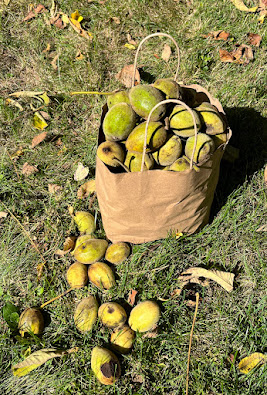There's a lot of gratitude being expressed towards trees these days. The gratitude tends to be towards trees in general, but this fall, I'm especially grateful for three trees in particular.
All three, growing at the TRI property, are among many that have been planted over the years by local nut tree expert Bill Sachs and me as part of an effort to bring back two marginalized native tree species. One is an American chestnut. The other two are butternuts. Both of these species have been laid low by introduced diseases, and I feel fortunate to be part of an effort to make them numerous once again in Princeton.
The two butternuts at TRI bore a bumper crop this year, some 200 nuts--the first sizable harvest since the parents to these two trees were lost 14 years ago. One fell in a storm; the other ironically was cut down as part of an environmental remediation. It's Bill who played the role of Noah, growing new seedlings from the seeds we collected from the two trees before they were lost.
We planted other members of this new generation of locally sourced native butternut trees at Harrison Street Park, Herrontown Woods, Mountain Lakes, and Stone Hill Church. Bill in particular did a lot of the followup work, checking the cages that protected them from the deer, and serving as a one man bucket brigade to sustain the trees through droughts in their first couple years.
Bill also did a great deal of work to re-establish native chestnut trees in Princeton. That project began in 2010, when chestnut researcher Sandra Anagnostakis, of the Connecticut Agricultural Experiment Station came to town to give a talk. She brought along 20 chestnut seedlings for us to plant in local parks. The seedlings were 15/16th native, 1/16th Japanese chestnut. Of all of those that Bill planted, at the Princeton Battlefield, TRI, Herrontown Woods, and Harrison Street Park, only the one tree at TRI has borne fruit. Many of the hybrid trees have died, despite the effort to breed in resistance.
There have been some other efforts to get the American chestnut growing again in Princeton, by the Friends of Princeton Open Space at Mountain Lakes and also by arborist Bob Wells at Greenway Meadows. The best bet for repopulating our world with the American chestnut may well lie in research that led to inserting a gene from wheat into the American chestnut genome that confers resistance. This seems a much more dependable and faster way to embed resistance to the fungus, and bring back this spectacularly useful native tree.
In the meantime, we can celebrate the hard-won harvest we're getting from this new generation of native nut trees, and after letting them cure a bit will even get to find out what a butternut tastes like.
Related posts
From 2010: The American Chestnut Returns to Princeton



